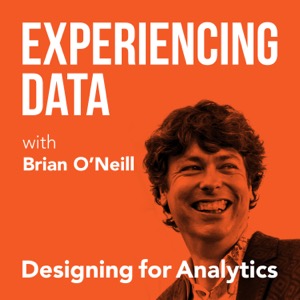165 - How to Accommodate Multiple User Types and Needs in B2B Analytics and AI Products When You Lack UX Resources
Experiencing Data w/ Brian T. O’Neill (UX for AI Data Products, SAAS Analytics, Data Product Management) - A podcast by Brian T. O’Neill from Designing for Analytics - Tuesdays

Categories:
A challenge I frequently hear about from subscribers to my insights mailing list is how to design B2B data products for multiple user types with differing needs. From dashboards to custom apps and commercial analytics / AI products, data product teams often struggle to create a single solution that meets the diverse needs of technical and business users in B2B settings. If you're encountering this issue, you're not alone! In this episode, I share my advice for tackling this challenge including the gift of saying "no.” What are the patterns you should be looking out for in your customer research? How can you choose what to focus on with limited resources? What are the design choices you should avoid when trying to build these products? I’m hoping by the end of this episode, you’ll have some strategies to help reduce the size of this challenge—particularly if you lack a dedicated UX team to help you sort through your various user/stakeholder demands. Highlights/ Skip to The importance of proper user research and clustering “jobs to be done” around business importance vs. task frequency—ignoring the rest until your solution can show measurable value (4:29) What “level” of skill to design for, and why “as simple as possible” isn’t what I generally recommend (13:44) When it may be advantageous to use role or feature-based permissions to hide/show/change certain aspects, UI elements, or features (19:50) Leveraging AI and LLMs in-product to allow learning about the user and progressive disclosure and customization of UIs (26:44) Leveraging the “old” solution of rapid prototyping—which is now faster than ever with AI, and can accelerate learning (capturing user feedback) (31:14) 5 things I do not recommend doing when trying to satisfy multiple user types in your b2b AI or analytics product (34:14) Quotes from Today’s Episode If you're not talking to your users and stakeholders sufficiently, you're going to have a really tough time building a successful data product for one user – let alone for multiple personas. Listen for repeating patterns in what your users are trying to achieve (tasks they are doing). Focus on the jobs and tasks they do most frequently or the ones that bring the most value to their business. Forget about the rest until you've proven that your solution delivers real value for those core needs. It's more about understanding the problems and needs, not just the solutions. The solutions tend to be easier to design when the problem space is well understood. Users often suggest solutions, but it's our job to focus on the core problem we're trying to solve; simply entering in any inbound requests verbatim into JIRA and then “eating away” at the list is not usually a reliable strategy. (5:52) I generally recommend not going for “easy as possible” at the cost of shallow value. Instead, you’re going to want to design for some “mid-level” ability, understanding that this may make early user experiences with the product more difficult. Why? Oversimplification can mislead because data is complex, problems are multivariate, and data isn't always ideal. There are also “n” number of “not-first” impressions users will have with your product. This also means there is only one “first impression” they have. As such, the idea conceptually is to design an amazing experience for the “n” experiences, but not to the point that users never realize value and give up on the product. While I'd prefer no friction, technical products sometimes will have to have a little friction up front however, don't use this as an excuse for poor design. This is hard to get right, even when you have design resources, and it’s why UX design matters as thinking this through ends up determining, in part, whether users obtain the promise of value you made to them. (14:21) As an alternative to rigid role and feature-based permissions in B2B data products, you might consider leveraging AI and / or LLMs in your UI as a means of simplif
